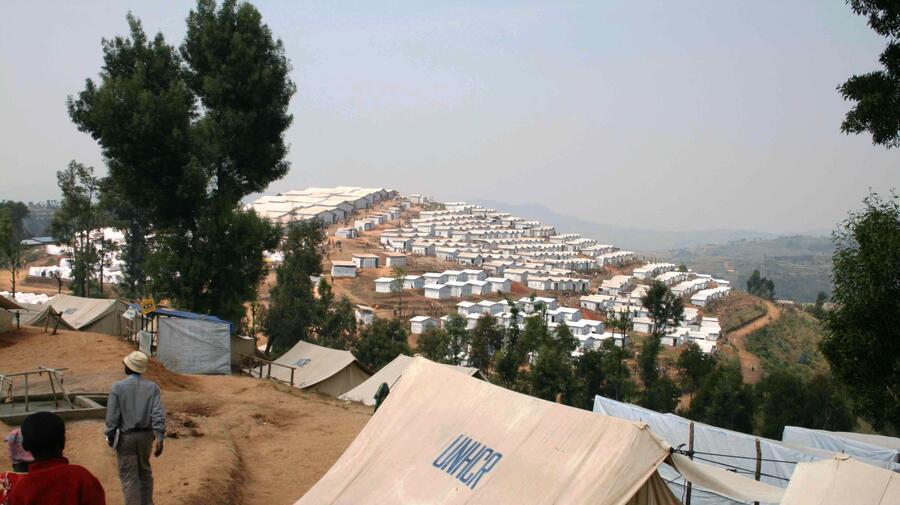UNHCR transfers hundreds of Congolese daily to new camp
UNHCR transfers hundreds of Congolese daily to new camp

Kigeme camp stretching as far as the eye can see.
KIGEME, Rwanda, July 18 (UNHCR) - In just a few weeks, UNHCR has built a new refugee camp in hilly terrain in southern Rwanda and transferred almost 10,000 Congolese refugees there from a crowded transit centre near the border with Democratic Republic of the Congo.
A further 8,700 are waiting to be moved to the camp at Kigeme from the Nkamira transit centre, which lies about 20 kilometres from the border with the Democratic Republic of Congo's North Kivu province.
They were among almost 20,000 Congolese who registered at Nkamira after fleeing across the border since late April to escape violence in North Kivu, including fighting between government soldiers and rebel troops. A steady stream continues to arrive.
Once the government of Rwanda had decided in late May to create a new camp in a bid to decongest the Nkamira transfer centre, the authorities of Nyamagabe district swiftly mobilized the local community to start working.
UNHCR's expert site planners made sure that the camp layout would utilize as much space as possible in the hilly terrain, which meant creating terracing. It was hard work, but the work teams of hundreds of men and women wilding hoes and shovels finished the preliminary work in a matter of days.
It was enough to erect tents for 1,300 family tents (about 6,500 people). Fourteen large warehouse tents were also put up to provide shelter for families alongside 631 shelters made from wood and mud. The first convoy of refugees arrived on June 10.
While UNHCR and the government are in charge of overall coordination of the emergency assistance at Kigeme, many partner groups and UN agencies such as UNICEF, the World Health Organization and the World Food Programme provide assistance in key areas such as hygiene, water and sanitation, health and food.
The facilities include latrines for men and women and a small health post set up by NGO partner, African Humanitarian Action. But refugees with complex medical conditions can also be referred to the local hospital, just a few kilometres away. Arrangements have also been made for primary school-age children to soon start attending the nearby school.
It's a long five-hour bus ride to Kigeme from Nkamira Transit Centre, but the faces of new arrivals soon light up. Nyirasafari, 48, stepped off the bus with her 11-year-old son, Benjamin, in tow. "Here I can see small houses and I can see happy faces," she said, adding: "I have only been here for a few minutes, but I can tell it is better than Nkamira. There, many of us had nowhere to sleep, we stayed outside."
With return to eastern Democratic Republic of the Congo unlikely for some time, an average of 500 people are being transported to Kigeme every day. Before the current influx, there were already 56,000 Congolese refugees living in three other camps (Giheme, Kiziba and Nyabiheke).around Rwanda, some for almost two decades.
Should their stay in Kigeme camp become protracted, UNHCR hopes to put every child in secondary school and to encourage adults to be self-reliant through livelihoods programmes that could also help them when they return home.
This is not the first time that Kigeme has been home to refugees. It hosted thousands of Burundians until May 2009, when they were able to repatriate without fearing for their safety. After they left, the site was reclaimed by nature - wild grass and trees grew on the slopes, and cattle grazed where refugees now live. Now, with tents sprouting like mushrooms, the area is covered as far as the eye can see.
By Anouck Bronée in Kigeme, Rwanda








